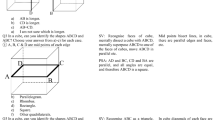Abstract
The primary goal of the study was to explore first-grade children’s reasoning about plane and solid shapes across various kinds of geometric representations. Children were individually interviewed while completing a shape-matching task developed for this study. This task required children to compose and decompose geometric figures to identify geometric shapes that either matched or did not match the stimulus shape. The stimulus shapes were 2D diagrams of plane and solid-shape geometric figures. The results showed that children overestimated the significance of triangular vertices (“pointiness”); certain kinds of scaling demands gave children trouble in shape classification; children had trouble translating lines found in 2D diagrams into 3D visual boundaries, especially where projected curvature was involved; and that children had difficulty reasoning consistently across the task. Implications for future research as well as teaching recommendations are discussed.




Similar content being viewed by others
References
Clements, D. H., Swaminathan, S., Hannibal, M. A. Z., & Sarama, J. (1999). Young children’s concepts of shape. Journal for Research in Mathematics Education, 30(2), 192–212.
Duval, R. (1995). Geometrical pictures: Kinds of representation and specific processings. In Exploiting mental imagery with computers in mathematics education (pp. 142–157). Berlin, Heidelberg: Springer.
Duval, R. (2006). A cognitive analysis of problems of comprehension in a learning of mathematics. Educational Studies in Mathematics, 61(1–2), 103–131.
Guay, R. B., & McDaniel, E. D. (1977). The relationship between mathematics achievement and spatial abilities among elementary school children. Journal for Research in Mathematics Education, 8(3), 211–215.
Gunderson, E. A., Ramirez, G., Beilock, S. L., & Levine, S. C. (2012). The relation between spatial skill and early number knowledge: the role of the linear number line. Developmental Psychology, 48(5), 1229.
Hegarty, M., Crookes, R. D., Dara-Abrams, D., & Shipley, T. F. (2010). Do all science disciplines rely on spatial abilities? Preliminary evidence from self-report questionnaires. In Spatial Cognition VII (pp. 85–94). Berlin, Heidelberg: Springer.
Herbst, P. (2004). Interactions with diagrams and the making of reasoned conjectures in geometry. ZDM, 36(5), 129–139.
IBM Corporation. (2013). IBM SPSS Statistics for Windows, Version 22,0. Armonk: IBM Corp.
Lonergan, B. (1997). In F. E. Crowe, & R. M. Doran, (Eds.), Verbum: Word and Idea in Aquinas, Vol. 2 of the Collected Works of Bernard Lonergan, Toronto: University of Toronto Press.
Ng, O., & Sinclair, N. (2015). Young children reasoning about symmetry in a dynamic geometry environment. ZDM Mathematics Education, 47(3). doi:10.1007/s11858-014-0660-5.
Noldus Information Technology. (2008). The Observer XT 8.0 [Computer software]. Wageningen: Noldus Information Technology.
Stannard, L., Wolfgang, C. H., Jones, I., & Phelps, P. (2001). A longitudinal study of the predictive relations among construction play and mathematical achievement. Early Child Development and Care, 167(1), 115–125. doi:10.1080/0300443011670110.
Steenpaß, A., & Steinbring, H. (2013). Young students’ subjective interpretations of mathematical diagrams: elements of the theoretical construct “frame-based interpreting competence”. ZDM - The International Journal on Mathematics Education, 46(1), 3–14, doi:10.1007/s11858-013-0544-0.
Thom, J.S., & McGarvey, L. (2015). The act and artifact of drawing(s): Observing geometric thinking with, in, and through children’s drawings. ZDM Mathematics Education, 47(3) (this issue).
Uttal, D. H., Meadow, N. G., Tipton, E., Hand, L. L., Alden, A. R., Warren, C., et al. (2013). The malleability of spatial skills: a meta-analysis of training studies. Psychological Bulletin, 139(2), 352–402.
van Hiele, P. (1986). Structure and insight: a theory of mathematics education. New York.
Wai, J., Lubinski, D., & Benbow, C. P. (2009). Spatial ability for STEM domains: aligning over 50 years of cumulative psychological knowledge solidifies its importance. Journal of Educational Psychology, 101(4), 817–835.
Author information
Authors and Affiliations
Corresponding author
Rights and permissions
About this article
Cite this article
Hallowell, D.A., Okamoto, Y., Romo, L.F. et al. First-graders’ spatial-mathematical reasoning about plane and solid shapes and their representations. ZDM Mathematics Education 47, 363–375 (2015). https://doi.org/10.1007/s11858-015-0664-9
Accepted:
Published:
Issue Date:
DOI: https://doi.org/10.1007/s11858-015-0664-9




